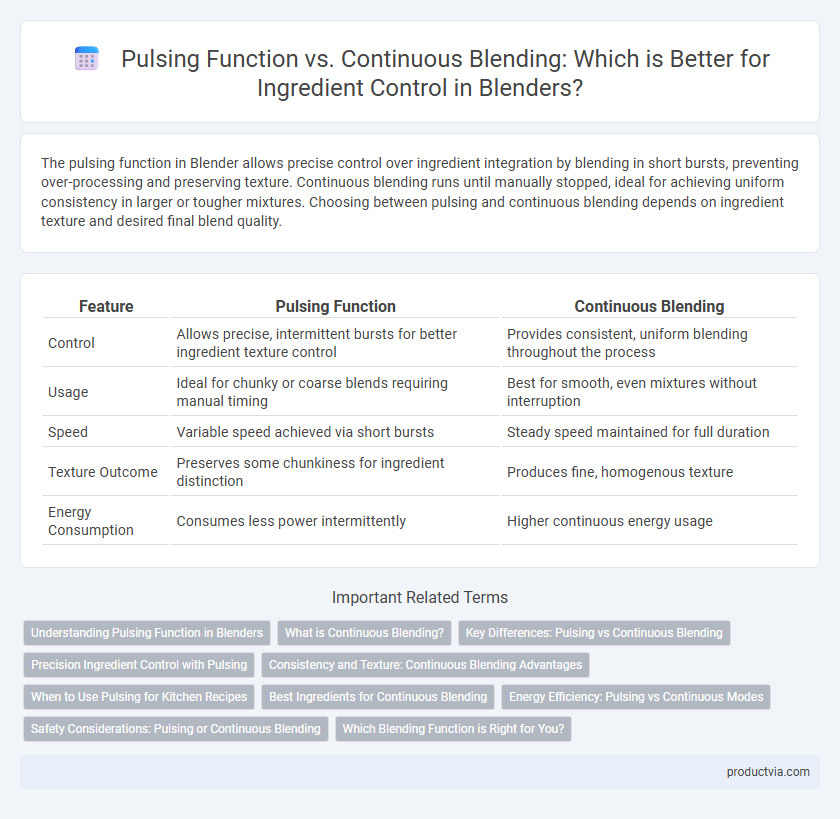The pulsing function in Blender allows precise control over ingredient integration by blending in short bursts, preventing over-processing and preserving texture. Continuous blending runs until manually stopped, ideal for achieving uniform consistency in larger or tougher mixtures. Choosing between pulsing and continuous blending depends on ingredient texture and desired final blend quality.
Table of Comparison
| Feature | Pulsing Function | Continuous Blending |
|---|---|---|
| Control | Allows precise, intermittent bursts for better ingredient texture control | Provides consistent, uniform blending throughout the process |
| Usage | Ideal for chunky or coarse blends requiring manual timing | Best for smooth, even mixtures without interruption |
| Speed | Variable speed achieved via short bursts | Steady speed maintained for full duration |
| Texture Outcome | Preserves some chunkiness for ingredient distinction | Produces fine, homogenous texture |
| Energy Consumption | Consumes less power intermittently | Higher continuous energy usage |
Understanding Pulsing Function in Blenders
Pulsing function in blenders offers precise control by delivering short bursts of power, enabling better texture management for ingredients like nuts or frozen fruits. Unlike continuous blending, pulsing prevents over-processing, maintaining desired chunkiness while avoiding overheating. This technique enhances control over ingredient consistency, making it ideal for recipes requiring varied texture.
What is Continuous Blending?
Continuous blending in Blender refers to a seamless process where ingredients are mixed without interruption, maintaining a steady and uniform texture. This method ensures consistent flavor and smoothness by keeping the blades running continuously at an optimal speed. Continuous blending is ideal for recipes requiring homogenous mixtures, such as smoothies or soups, optimizing texture and blending efficiency.
Key Differences: Pulsing vs Continuous Blending
Pulsing in Blender operates by delivering short, controlled bursts of motor power, allowing precise control over ingredient texture and minimizing over-processing, ideal for chunky results. Continuous blending runs the motor uninterrupted, creating smooth and consistent blends but with less control over texture, suitable for emulsions and purees. The key difference lies in texture management, where pulsing offers intermittent mixing for coarse consistency, whereas continuous blending provides uniform homogenization.
Precision Ingredient Control with Pulsing
Pulsing function in Blender offers precision ingredient control by delivering short, controlled bursts of blending power, allowing for exact texture and consistency adjustments. Continuous blending runs at a steady speed, which may over-process delicate ingredients or lead to less precise mixing. Using pulsing enables better customization and prevents over-blending, ideal for recipes requiring specific ingredient textures.
Consistency and Texture: Continuous Blending Advantages
Continuous blending in Blender ensures uniform consistency and smooth texture by maintaining a steady mixing speed and avoiding sudden interruptions. This method minimizes the formation of lumps or uneven particle sizes, resulting in a more homogeneous blend ideal for sauces, smoothies, and purees. Continuous blending also preserves ingredient integrity by preventing over-aeration, which can negatively impact the texture and final product quality.
When to Use Pulsing for Kitchen Recipes
Pulsing in Blender is ideal for recipes that require precise control over texture, such as chunky salsas or nut butters, where ingredients need short bursts of blending to avoid over-processing. Continuous blending suits smoothies or soups, where a consistent, smooth texture is desired by blending ingredients continuously over a set time. Use pulsing when you want to retain texture variation or avoid overheating ingredients, ensuring better flavor and nutrient preservation.
Best Ingredients for Continuous Blending
Continuous blending in Blender is ideal for achieving smooth, uniform textures by maintaining a steady mix, which is perfect for soft fruits, leafy greens, and liquids like yogurt or almond milk. Best ingredients for continuous blending include ripe bananas, frozen berries, spinach, and avocado, as they break down effortlessly to produce creamy, consistent results. Pulsing functions are better suited for chunkier textures or to prevent over-processing delicate ingredients.
Energy Efficiency: Pulsing vs Continuous Modes
Pulsing mode in Blender optimizes energy efficiency by delivering short, powerful bursts of motor activity, reducing overall power consumption compared to continuous blending, which maintains a constant energy draw. This intermittent operation minimizes heat generation and motor strain, extending appliance lifespan and lowering electricity costs. Continuous blending ensures consistent texture but consumes more energy, making pulsing ideal for recipes requiring precise ingredient control with minimal power use.
Safety Considerations: Pulsing or Continuous Blending
The pulsing function in Blender offers precise control over ingredient texture, reducing the risk of overheating and splattering by operating in short bursts. Continuous blending achieves consistent texture but may cause motor strain and increase the chance of spills due to prolonged operation. Prioritizing safety, pulsing minimizes motor wear and enhances user control, ideal for tougher ingredients or small batches.
Which Blending Function is Right for You?
Pulsing function in Blender offers precise control by delivering short bursts of power, ideal for chunky textures or chunky ingredients needing careful processing. Continuous blending provides consistent, smooth results by maintaining a steady power flow, perfect for purees, smoothies, or soups requiring uniform texture. Choose pulsing for ingredient control and texture variation, or continuous blending for seamless, consistent blends based on your recipe needs.
Pulsing function vs Continuous blending for ingredients control Infographic

 productvia.com
productvia.com